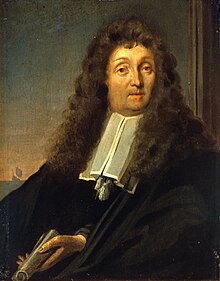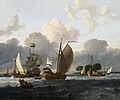Ludolf Bakhuizen
Ludolf Bakhuizen , often also Backhuysen, (born December 28, 1630 or 1631 in Emden ; † November 7, 1708 in Amsterdam ) is considered the most popular Dutch marine painter alongside Jan van de Cappelle and Willem van de Velde ( father and son ).
Although he is best known as a marine painter, there are also biblical subjects, portraits and landscape paintings by him and in addition to (around 600) paintings, drawings and etchings have also been preserved.
There are different spellings for the name. Backhuysen signed both as Bakhuizen and Backhuysen (where he mostly used monograms, LB, L Back, L Bak.) And wrote his first names both Ludolf and Ludolph. At different times the father wrote himself Backhusz or Backhusen, Bachhuss, Bachuis, Bachuizen, Backhuijsen, Bakhuizen.
Life
His parents were the court clerk and from 1631 a notary in Emden Gerhard Backhusen and his wife Margarete Janssen. The father had previously worked as a clerk in Aurich and Norden and fled the ravages of the Thirty Years' War from East Frisia to safe Emden, where he was granted citizenship. In addition to the sons Ludolf and Johannes, there was also a daughter born in 1628.
Bakhuizen grew up in Emden, which had its heyday in the 16th century and was already showing signs of decline. He went to Amsterdam in 1650 and went there as a clerk into the trading company Bartolotti, the head of Guillelmo Bartolotti was born in Emden, but already moved at the age of one year in 1603 to Amsterdam. They resided on the elegant Herengracht in a Renaissance town house that still exists today. In addition to his work as an office clerk, he was also used as a calligrapher because of his beautiful handwriting and gave lessons. According to his biographer Houbraken, he was a self-taught painter and draftsman. To learn the art of painting, he went to the marine painters Allart van Everdingen (1621–1693) and Hendrik Jacobsz Dubbels (1621–1707) as an apprenticeship from around 1651 . His first known pictures date from 1658. In his painting he was also influenced by the then most famous marine painter Willem van de Velde the Elder (and probably also by his equally famous son van de Velde the Younger ). In 1663 he was accepted into the St. Lucas guild of Amsterdam painters. After the van de Veldes left for London in 1672, Backhuysen became the most famous marine painter in Amsterdam and the Netherlands. He painted his last pictures in 1707. Backhuysen achieved reputation and prosperity with his own house in the Herengracht near the Westerkerk. He died after a long, painful illness (he suffered from bladder stones).
He devoted himself primarily to marine painting and soon rose to prominence in Europe; his pictures were in great demand well into the 19th century. In addition to marine paintings, he painted portraits (including some self-portraits and portraits of family members), few landscapes and biblical scenes and no still lifes. Hofstede de Groot lists 573 paintings. Grisailles have also been preserved from him .
According to the biographer Houbraken, he gave drawing lessons to Peter the Great during his stay as a ship carpenter's apprentice in Amsterdam in 1697. In 1665 he received the honorable commission from the city council of Amsterdam to paint a picture of Amsterdam for the foreign minister of Louis XIV, Hugues de Lionne (Marquis de Berny), an art collector ( shipping in the roadstead of Amsterdam , 1666, Louvre) .
Meyers Lexikon wrote in the 1880s: While his smaller depictions of the slightly moving and stormy sea are characterized by careful observation of nature and a fine, tasteful, if cool coloring , he loses himself on his extensive seascapes in a smooth and colorful one Decorative painting . His earlier works are preferable to the later ones. The best are in the Berlin Museum (from 1664), in the Palazzo Pitti in Florence (1669), in the Vienna Belvedere Palace ( Austrian Belvedere Gallery ) and in private English galleries. His etchings are very much appreciated.
In 1701 he published a series of ten etchings under the title Stroom en Zee gezichten , including a view of Emden as the only foreign city.
Backhuysen was married four times. His first two wives (marriage in 1657 and 1660) died early. In 1664 he was married to Alida Greffet, who had a silk shop, in his third marriage. With her he had a daughter Maria (born 1665). With his last wife Anna de Hooghe (1645-1717), a merchant's daughter (marriage 1680), he had three sons, of whom only Joannes (1683-1731) reached adulthood. He was later a wealthy merchant. There are still descendants in the Netherlands today, including the professor of church and dogma history (until 1966) at the University of Leiden JN Bakhuizen van den Brink.
literature
- Gerlinde de Boer Ludolf Backhuysen 1631-1708. His life and work , Zwolle 2001 (with catalog raisonné)
- Wilhelm Adolf Schmidt: Backhuysen, Ludolf . In: Allgemeine Deutsche Biographie (ADB). Volume 1, Duncker & Humblot, Leipzig 1875, p. 777 f.
- General artist lexicon . Volume VI, 1992, page 175
- Henri Nannen (editor) Ludolf Backhuysen. Emden 1630- Amsterdam 1708 , Ludolf Backhuysen Gesellschaft, Emden 1985 (for the exhibition of Backhuysen's works in the Nederlands Scheepvaart Museum Amsterdam and in Emden)
- Arnold Houbraken De Groote Schouburgh of the Nederlantsche Konstschilders en schileressen , 3 volumes, 1718 to 1721 (to Backhuysen Volume 2, pp. 185–192)
- Friedrich Scheele, Annette Kanzenbach (editor): Ludolf Backhuysen. Emden 1630 - Amsterdam 1708, Ostfriesisches Landesmuseum Emden, issue 27, 2009 (exhibition catalog of the exhibition from November 30, 2008 to March 1, 2009, including Peter Sigmond Ludolf Backhuysen and the naval history in the Netherlands ), review by Jenny Gaschke
- Werner Teupser: Backhuysen, Ludolf. In: New German Biography (NDB). Volume 1, Duncker & Humblot, Berlin 1953, ISBN 3-428-00182-6 , p. 506 ( digitized version ).
gallery
Arrival of the royal governor Willem III. in Oranjepolder 1691 , 1692, Mauritshus, The Hague
Ships in the Zuidersee in front of the Fort von Naarden , 1660s, Wallraf-Richartz-Museum
Embarkation of marines in the Texel roadstead, in the middle the Golden Lion, the flagship of Cornelis Tromp , 1671, Rijksmuseum
Naval Battle of Vigo , 1702, National Maritime Museum
Individual evidence
- ↑ For example Thieme-Becker, Künstlerlexikon , and in the exhibition catalog Emden 1985. Backhuysen wrote himself in the wedding register of Amsterdam.
- ↑ The date of birth is not entirely certain. It is possible that he was born in 1631, as stated by Houbraken and Hofstede de Groot. There is a dedication poem for his 72nd birthday by his son Joannes, which is ambiguous regarding the year of birth. His other notes also allow both interpretations, for example the self-portrait 1698, where he gives his age at 67. Ludolf Backhuysen's baptismal register entry for the Reformed Parish of Emdens is missing, but there is an entry for his brother Johan Fridrich on September 8, 1629 (not 1630, as the Amsterdam catalog 1985 states). In the wedding register of Amsterdam from August 1657 he is given as 24 years old, which corresponds to the year of birth 1632 and a baptism in early 1633. This would explain a missing entry in the baptismal register, as there was a gap from 1633 to 1641. Houbraken gives December 18th as his birthday due to the Julian calendar still valid in Emden at the time of his birth. The family tradition and the Emden exhibition catalog (Hajo van Lengen, p. 53) speak for 1630. The Amsterdam exhibition catalog from 1985 suggests 1631 as the year of birth. Henri Nannen in Ludolf Backhuysen , Emden 1985, p. 15 f.
- ↑ In the family book of the Backhuysens, 1 a.m. on November 7 is given and the age is 77 years, 10 months and 9 days, Henri Nannen (Ed.) Ludolf Backhuysen , Emden 1985, p. 161 (illustration of the entry)
- ↑ The mother died in 1680 with her son in Amsterdam
- ↑ He was registered as a notary in Emden until 1661.
- ↑ Dedication on the 300th anniversary of death in the Anzeiger für Harlingerland of December 13, 2008. Henri Nannen (Ed.), Exhibition catalog Emden 1985, p. 26.
- ↑ The family came from Bologna and came to Amsterdam via Stade, Hamburg, Emden.
- ↑ Herengracht 170–172
- ↑ He came to Amsterdam from Haarlem in 1657.
- ^ Ships in the coming storm, Museum of Fine Arts, Leipzig
- ↑ Hofstede de Groot lists 17. One of the pictures The Shipwreck of Saint Paul (Emden, Landesmuseum) from the 1690s is also a naval picture.
- ↑ It is said that Peter the Great visited studios and bought paintings during his stay in Amsterdam.
- ↑ The location of the paintings or collections relates to the year 1878, they may be in other locations today.
- ↑ Brockhaus, 4th edition, 1888–1890
-
↑ De Boer's catalog raisonné overtakes the previous two in:
- C. Hofstede de Groot: Descriptive and critical directory of the works of the most outstanding Dutch painters of the 17th century , in 10 parts, Esslingen and Paris 1907–1928
- John Smith: A catalog raisonné of the most eminent dutch, flemish and french painters , London 1829–1842
Web links
- Literature by and about Ludolf Bakhuizen in the catalog of the German National Library
- Ludolf Backhuysen in the culture portal Northwest
- To the meteorology at Lv Backhuysen (PDF)
| personal data | |
|---|---|
| SURNAME | Bakhuizen, Ludolf |
| ALTERNATIVE NAMES | Backhuijzen, Ludolf; Backhuysen, Ludolph; Bakhuysen, Ludolf |
| BRIEF DESCRIPTION | Dutch marine painter |
| DATE OF BIRTH | December 28, 1630 or December 28, 1631 |
| PLACE OF BIRTH | Emden , East Frisia |
| DATE OF DEATH | November 7, 1708 |
| Place of death | Amsterdam |


























